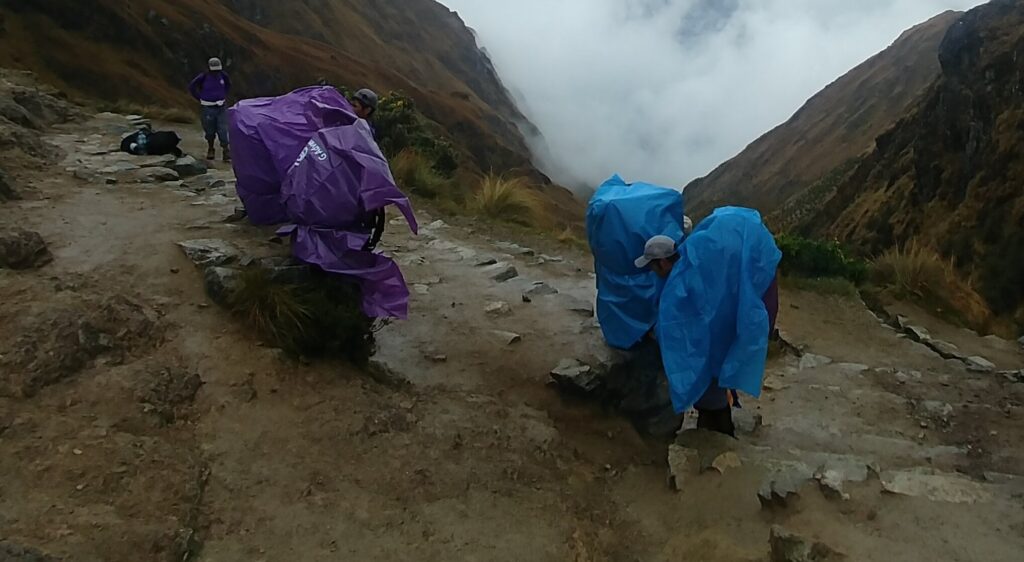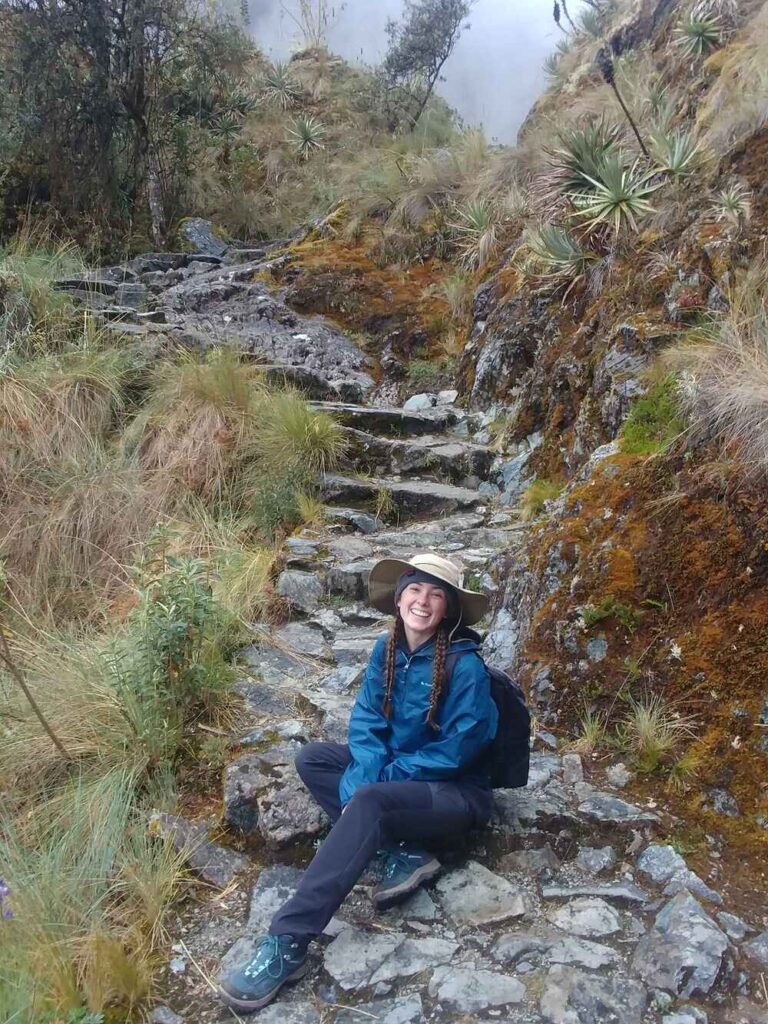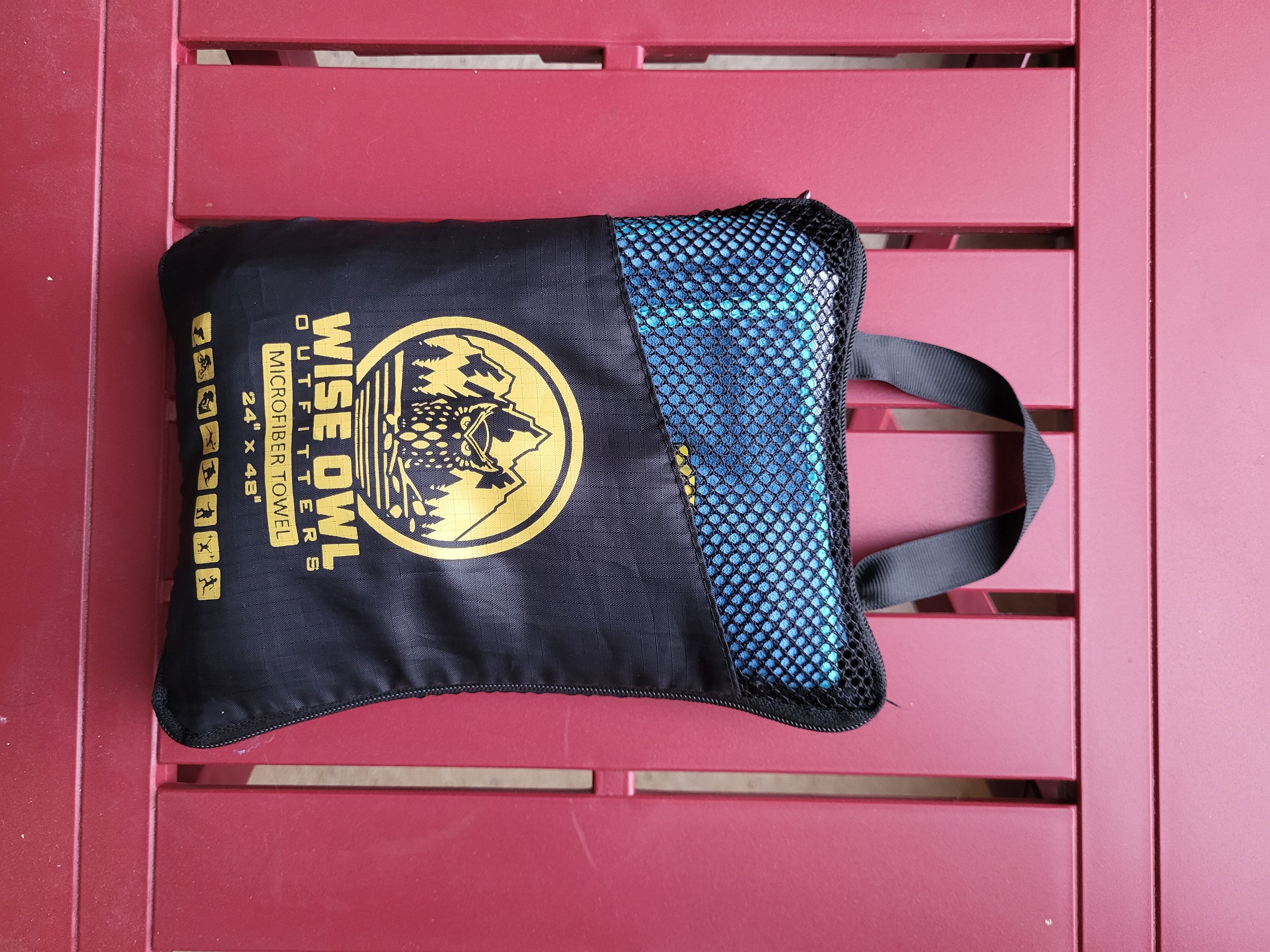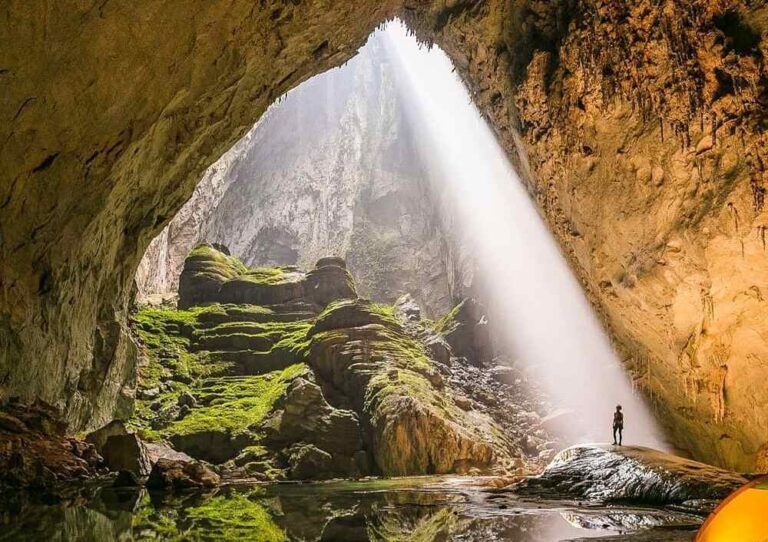So you’re hiking Machu Picchu through the Inca trail? Are you ready to start packing but don’t know where to start? I’ve made a list of all the things I was glad to have when hiking the Inca trail, and why they were important.

The Inca Trail stands as a testament to ancient civilizations and offers adventurers an unparalleled hiking experience. This trail winds its way through lush cloud forests, mountainous terrain, and ancient Incan ruins, culminating in the finale at the legendary Machu Picchu.
The trail offers four days of trekking consisting of cold nights, warm days, rainy clouds, high mountains, deserts, rain forests, thousands of steps, camping, star gazing, and photo taking. It’s an exciting experience, but it can be quite daunting – starting from the packing.

I completed the Inca trail hike in the summer of 2022. I was arriving in Peru with a bag full of necessities from other trips, so I was quite selective about what I brought. As an avid camper and hiker, I have my key travel items with me on every trip. In turn, as you prepare to embark on this hike, the importance of planning cannot be overstated, and a well-curated packing list becomes your compass for a successful and enjoyable trek.
In this post, I’ll delve into the essentials you need to consider when assembling your Inca Trail packing list. Whether you’re a seasoned hiker or a first-time adventurer, this list will ensure you’re well-prepared to enjoy the wonders of the Inca Trail.
Important to know before you start packing
Before we dive in, I must state the limitations of your luggage.
It is important to note that some of your items that will not be needed on the trek will be left in a storage room of your hotel before making your way to the trailhead. Everything you can bring will be divided into 2 lightweight bags.
Bag 1 will be your own daypack that you carry with you on the trail. This can consist of whatever you want/need for the day’s trekking. I would recommend a smaller hiking bag, around 20-30L. I used the Nevo Rhino Bag which did the trick for me!
Your tour company will provide bag 2, which will consist of the other items you should have on the trip but won’t necessarily need throughout the day (Night clothes, camp shoes, toothbrush, etc.). This bag has a limited weight limit since it will be carried by porters to and from campsites. (This should be included in the cost of the trip)

Porters are responsible for carrying all food, tents, cooking supplies, and night packs for travelers and themselves, so we try to help them by packing light. They are amazing people with superhuman strength and speed on those trails.
Rentals
You should have the opportunity to rent your tent, sleeping bag, and hiking poles, so if you can’t fit them in your travel bag on the way to Peru, you should still be okay! I would also probably recommend you rent their equipment considering it was bought specifically to withstand the conditions on the trail.
- Tent
- Sleeping bag
- Hiking poles
The hike can be difficult at times, so packing light is the key to a happier trip, but making sure your small amount of items covers everything you will need can be quite difficult.
Onto the Inca Trail Packing List
Gear for Hiking Machu Picchu
Hiking Shoes
Much like any good trail, good shoes are a necessity. The trail consists of so many different terrains – rocky, dirt, smooth stone, steep pass – and all of it can be very slippery when wet.
I highly recommend waterproof hiking shoes, so if you have any rainy days you won’t have to worry about your feet getting soaked. It’s a pain walking multiple days with wet feet. I’m also a huge fan of ankle support, so I personally would suggest some shoes with higher ankle coverage. I used hiking boots from Decathlon that I wear everywhere. Colombia also sells really good hiking shoes that are highly recommended for long-trail hiking.
If you are getting new shoes/boots for this trip you should try to wear them out a few times before the trek to avoid blisters. Blistered feet at any point of the trail can make your trek extremely uncomfortable and ruin your experience.
Daypack Backpack
How much stuff goes into your day pack is entirely up to how big your bag is and how much you want to carry. Considering the days can be quite long, and the trail quite demanding, the less you have the carry the better.
With that said, you will need more than a handbag for the day. You will need to be carrying the things you need access to throughout the day like water, snacks, sunscreen, etc. I had a small travel backpack that was light but barely big enough to carry all my stuff. I would recommend a better pack made for hiking and better for your back so it doesn’t hurt you like mine did. My friend had the Venture small hiking travel pack that worked super well.
Headlamp/Flashlight
Up in the mountains, away from the city lights at night, it can get quite dark. Especially after dinner, when the sun starts to go down and you need to navigate through hundreds of tents to find the washrooms, and then back to your tent, it can get really hard to see. A headlamp or flashlight is necessary for night camp navigation.

Sleeping bag (optional)
A good sleep is so welcome after a long day of trekking. It’s also necessary to be well-rested when starting your hike early the next morning, and that starts with warmth.
Not only does it get dark pretty fast up in the hills. The altitude change and exposure to so much wind can make it pretty cold at night. I wore a few layers of clothes, my hat, my buff, and my gloves, but my sleeping bag did most of the work in keeping me warm at night. A proper sleeping bag that is lightweight and appropriate for 0 degrees F. weather is highly recommended.

Do note that your sleeping bag goes into your Bag 2 items list – meaning that it counts toward the available room you have been carried by the porter. So the bigger the sleeping bag, the less clothes you can bring.
If you don’t have a lightweight sleeping bag or don’t have room to bring one, fear not because you can rent a sleeping bag and a sleeping liner. These cost about 15 – 20 CAD.
Clothes for the Trail
Go unprepared and you will be either too wet or too cold at some point on the trail. Maybe even both. I’m a minimalist when it comes to hiking, so I often re-wear my socks and hiking clothes. Some people like a little more luxury than this and that is totally fine, but you will need to sacrifice some hygiene for this hike.
Here are all the clothes I would recommend bringing.

Moisture-Wicking Socks X2
Take care of your feet, you will need them for the hike. Wool socks are light, fast drying, comfy and breathable. Pack enough for the entire trek to keep your feet dry. I usually pack 1 pair of socks for every 2 days of hiking so they aren’t too dirty and it’s still quite light on the packing.
Weather-Appropriate Clothing for Hiking Machu Picchu
Layer up for varying temperatures. It can be pretty cold in the mornings and high up in the mountains, but you will get hot when hiking during the day with the sun out. Prepare for comfort in both rain and shine.
I recommend at minimum the following:
- 2x hiking shirts (1 short sleeve & 1 long sleeve) – avoid anything cotton, those take forever to dry and collect sweat and dirt faster than other materials
- 1x Hiking Pants/Convertible Pants – to cover both shorts and pants. opt for quick-drying and breathable materials.
- 1x light fleece – for extra warmth
- 1x puff jacket – this is lightweight but very warm
- 2x camp shirts to change into at camp for dinner and bed
- 1x camp pants
- 2x camp socks

Hats
I say hats as a multiple. You will need one hat during the day – a wide-brimmed hat for sun protection during the long hikes. I use my wide-brim hat bucket hat for every hike. It shades my whole face and the string allows me to carry it over my shoulder if I don’t want to wear it.
You may also want a beanie for cooler nights. Any kind of warm beanie to keep your head and ears warm works. I also wore both at points when it was cold and sunny.
Waterproof Gear
The weather can be iffy in the mountains, and during the rainy season, it can get very wet. I found that even during the dry season, there was a lot of mist and moisture in the air, which just caused everything to be wet.

Being soaking wet when hiking can cause so much misery. Having wet clothes, socks, a backpack, and rain constantly dripping down your face just doesn’t equal a good time in the woods. Make sure to get a good, lightweight raincoat and pants if you can. A rain poncho would also do. Just something that would keep the rain off of you in case it does drizzle or rain. I used this compact raincoat from Decathlon that compressed tight and fit well in my bag when I didn’t need it.
Good rain gear can also act as another layer of warmth on cold days, so it’s definitely worth the investment!
Personal Items
Sun Screen
The sun is super strong so high in the mountains, so be sure to protect yourself from sunburn.
Insect Repellent (Or Mouthwash)
I like to pack a travel-size pack of mint mouthwash – this sounds odd but bugs hate the smell of mint. Dab some on your neck and you are golden, plus it doesn’t hurt the bugs.
Toiletries
This is a fun one.
- Toilet paper!!!

I cannot stress this enough. Bring a roll of toilet paper for yourself. Most of the trail will not have toilet paper to provide you, so having a stash to yourself both on the trail and at camp is a huge luxury. Without it you may be a little dirtier than you’d hope while hiking.
- Toothbrush/Toothpaste
- Hand sanitizer
- Face/wet Wipes
- Extra hair ties
These are for the end of the day to wipe off the sweat and grime collected on your body. Consider it a wipe-down shower. It helped me feel a little more refreshed before going to bed.
First Aid Kit
On any adventure, there is always a chance of getting hurt, a small personal first aid kit can go a long way. Customized to your preferences and care, it’s golden in most situations. If you’re interested in a travel-sized kit example, you can look here. You should include the basics first and foremost:
- Blister aid
- Polysporin
- Scissors + gauze
- Band-aids

Then, include things that may be more useful to you:
- nail clippers
- pain killer medicine
- earplugs
Technology needed for Hiking Machu Picchu
Phone/Camera/Lenses
I feel like this one is a given for most people. Your hike is going to be an amazing experience and I think it’s worth documenting your days with photographs. I found my phone was sufficient enough, but I am no photographer. For those who love good angles, the trail offers you unlimited views, so a good camera, with a great lens may be worth the weight.

Portable Charger
The trail provides you with so many amazing photo opportunities between the Inca ruins, the trail landscapes, different microclimates, and the lookouts. You do not want to run out of battery before you can take a photo of the scenic views around you all throughout the trail.
Documents needed for Hiking Machu Picchu
Passport
You cannot start, or even enter the Inca Trail without your passport being verified for your permit. You will also need it to enter Machu Picchu. Even if you have paid for the tour and are all set to go, if you do not have your passport, you will not be allowed on the trail!
Money
It’s always good to have some money on hand, even in the remote trails of the wilderness. There are little shops near the beginning of the trail where you can buy last-minute snacks and power drinks from.
Also, by the end of the trip, it’s nice to be able to tip your porters for the amazing trail running, gear carrying, and camp setup they do. They are true superheroes that make your life super easy. So although it is not required, it is encouraged to tip your porters at the end of the trip. However, you may not see them once you leave Machu Picchu, so keep some cash on hand for them on the last day.
Extra Optional Items when Hiking Machu Picchu
Finally, we have hit the bottom of the packing list. I have gone through everything that I thought was necessary for the trek, but I did intentionally leave off a few items that I would consider optional, and preferred by some. Below is a list of items that I saw others bring.
Trekking Poles
I personally didn’t use trekking poles, and the hike is very doable without them.
Snacks
With how much energy you burn while walking up the steps of each mountain it’s so important to keep fueling your body with snacks and water. A lack of food or water when walking can cause shakes, and muscle cramps that can severely injure you. I highly recommend you keep some kind of snack close by at all times on the trail. I tend to keep a multitude of snacks for different occasions.
Something like Clif Bars or granola snacks are always good options. Protein-rich and healthy to munch on while you get some energy back. Additionally, try packing a motivational Snack. It’s usually a cheat snack – something covered in chocolate (for me at least).
Towel
Personally, I like having my own mini towels – one for daytime to wipe off sweat, and one for night to wash my face. It’s the little luxuries that make me happy. I use Wise Owl camping towels for all of my travel and camping. They are just compact, really small and they have always been reliable for me.

Notebook/pen
If you are one to write in a journal, document your days, record a log book and just like to have paper at hand for fun thoughts and poems, a notebook and pen may be a good idea. I found a lot of awe-invoking moments and instances of inspiration, and I hope you do too.
Sleeping Mat
Your company should provide you with a small sleeping pad. This pad is thin and not meant for the ultimate comfort. I used just the pad and I was fine but I do know I can sleep in most uncomfortable places. If you are so inclined, you may want to bring a sleeping mat. This will take up more space in your bag, but good sleep is worth it on the trail. I would say get a mat with a thermal base meant for colder temperatures.

Travel Pillow

Pillows are not provided on the trip. You can use a sweater or towel as a headrest, but travel pillows do provide a small luxury that can make all the difference.
Sleeping Mask
If you like absolute darkness when you sleep, a sleeping mask may be useful to you. I have even been recommended a mask with speakers multiple times. It seems that the built-in allows you to listen to music or white noise comfortably and quietly. If you’re interested, take a look at these ones: Sleeping Mask
The Breakdown of Items
I’ve compiled this list into the separate bags I recommend you keep each item in.
Daypack
- Gloves/hat
- Snacks
- Camera/phone
- Rain Coat
- Toilet Paper/hand sanitizer
- Water Bottle
- Sun hat
- Sunscreen/bug repellant
- Passport
- Money
Porters Pack
- Sleep clothes
- Change of hiking clothes
- Dry Towel
- Head Lamp
- Camp Shoes
- Sleeping bag
- Portable charger
- Extras
Here is my full list of important things to pack when venturing up the mountains to Machu Picchu! Tailor this list to your personal needs and preferences, and you’ll be well-prepared to conquer the challenges and savor the wonders of this iconic trek. Safe travels!
Related Posts
If you are wondering what to expect, or what it’s like on the trail, I’ve written about my experience: What to Expect when Hiking the Inca Trail.
If you haven’t booked your trip yet, or you are looking for recommendations of who to book your trip with, I have also written about my experience with the G-Adventures Tour of Peru. GAdventures Peru Multisport: My Review (You cannot hike the Inca Trail Independently – you must go with an approved tour)
About the Author

Hi, I’m Shannon. A small travel lover with a laptop.
I’m an avid plane rider and backpacker, currently traveling between lots of working days. This year I am making travel my #1 priority, and I plan to document it as much as I can.






